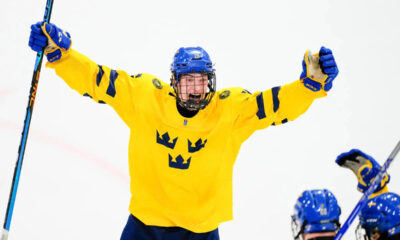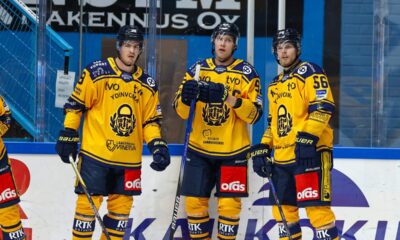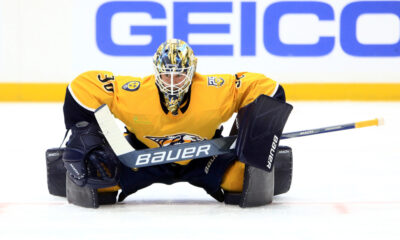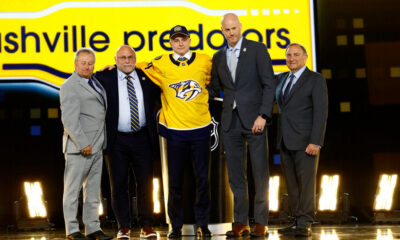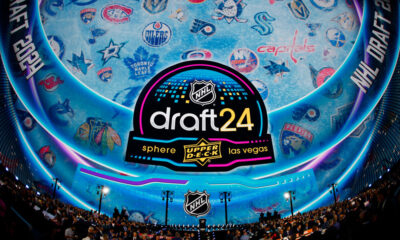With three picks in the 50s of the 2024 NHL Draft, the Nashville Predators won’t just be focused on their first-round pick but could also analyze opportunities to trade up after the 22nd overall selection. That range should feature a number of intriguing forwards, potentially including the prospects below.
Igor Chernyshov | W | Dynamo Moskva (KHL)
Igor Chernyshov is one of my ideal prospects in the 2024 NHL Draft. The 6’2″ winger’s chance of falling depends on how unwilling teams are to draft Russian prospects, although his current contract only runs through next season. The 18-year-old forward grew up in the Dynamo Moskva system and made his KHL debut in the 2022-23 campaign. After a point-per-game year in the MHL that year, he earned a big promotion to the pro club this year, scoring three goals and four points in 34 games (albeit with just over eight minutes in average ice time). He chipped in 28 points in 22 MHL games this year too.
Chernyshov is an above-average skater who is constantly moving his feet. With the puck, he attacks the offensive zone, pushing defenders back and forcing them to be at their best. Off the puck, he’s a pro at puck support; if his teammates can’t find a passing option in transition, Chernyshov will circle back at full speed, keeping his wheels moving to confuse forecheckers and open up space.
The Russian winger is also a good puck handler. He’ll manipulate his wrists to execute creative passes and work around defenders; and if his moves don’t work, he chases down those mistakes. Chernyshov can still work on keeping his hands and feet moving at the same time, especially when trying to beat a defender to the outside. In those moments, you’d like to see him drop his shoulder more and push off the opponent. Defensively, Chernyshov’s posture is better as a forechecker than he is in his own end; he takes good angles and stops and starts to change directions but could improve his board play getting the puck out of his zone.
Chernyshov’s calling card is very clearly his endless motor. But he displays a two-way responsibility that will help him succeed at the pro level in combination with his good scoring touch.
Nikita Artamonov | W | Torpedo Nizhny Novgorod (KHL)
There’s been an ongoing debate about who’s the better Russian prospect: Chernyshov or Nikita Artamonov. For me, it’s the former, but their profiles don’t diverge too much. Artamonov stands at 5’11” and matriculated pretty much full-time to the KHL this year. In 54 games with Torpedo Nizhny Novgorod, he scored seven goals and 23 points, leading all U19 draft-eligible forwards league-wide.
Similar to Chernyshov, Artamonov has an impressive motor. But where the former is a north-south driver, the latter uses lateral moves and delay tactics on offense more effectively. Artamonov excels at a give-and-go style of play and is one of the more creative passers in the NHL Draft. While he’s got a good set of hands, he wasn’t without growing pains and turnovers in the pros this year. I’m confident, however, that he’ll develop his playmaking coming out of dekes in due time.
When forechecking, Artamonov attacks the puck carrier directly, disrupting tons of plays with his physical edge too. His in-zone defensive play isn’t much to write home about, but he can get the job done and shows a good ability to kickstart his team’s transition.
The big flaw in Artamonov’s game is his skating. It’s not horrible—and after a few strides his mechanics improve, but his stride is inconsistent, his upper body remains unnecessarily busy, and he isn’t explosive when changing directions. Despite that, Artamonov plays a game that’s at least translatable to a bottom-six NHL role; teams will be hoping he can translate his tenacious puck-pursuit skills and nose for high-danger scoring areas too.
Emil Hemming | W | TPS (Liiga)
Switching gears to Finland, Emil Hemming is a winger who comes with mixed reviews. The 6’1″ forward made his Liiga debut this year, scoring seven goals and 11 points in 40 games for TPS. He also added 18 points in 13 U20 league games and combined for eight points in 12 games at the U18 and U20 World Junior Championships (WJC).
Much like Artamonov, there’s been some consternation over Hemming’s skating, but I’d argue the latter’s mechanics are better. Hemming does display some weird stride recoveries at full speed sometimes, but overall, I’d grade him as an average skater.
His offensive value comes from his shooting talent. Hemming has a heavy wrist shot, and he can score from a distance; toward the end of the season, his one-timer skills became clearer too, adding to his work on Finland’s power play at the U18 WJC. Outside of his shot, though, Hemming lacks some creativity with the puck; he doesn’t have the softest hands in the world but can be a perfectly fine puck mover in transition. What frustrates you is how often he works himself into the wall or a giveaway situation, but his problem-solving skills should improve somewhat as he plays more pro games.
On the forecheck, Hemming is physical and effective. But once his team recovers possession, his off-puck IQ vanishes at times as he floats somewhat aimlessly in the offensive zone while his teammates try to make a play. At the other end of the ice, I find Hemming’s defensive skills to be underrated and can see him winning plenty of wall battles in the NHL one day.




